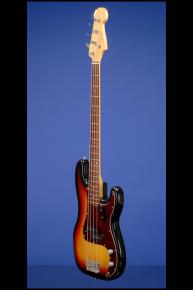A Near Mint Fender Precision Bass.
1968 Fender Precision Bass.
This forty-two year old 13-inch-wide bass guitar weighs just 8.90 lbs. and has a nice comfortable nut width of 1 5/8 inches and a full bass scale length of 34 inches. Solid alder body contoured on back and lower bass bout, one-piece maple neck with a medium to thick profile, and veneer rosewood fretboard with 20 frets and pearloid dot position markers. Single circular string tree. Original Fender 'paddle-gear' tuners. Headstock decal with Fender logo in silver with black trim, "Precision Bass" in black beside it, four patent numbers and one design number beneath that. Four-bolt neckplate with the large "F" logo and serial number "211261" between the top two screws. One split black eight-polepiece pickup. Four-layer (tortoiseshell/white/black/white) plastic pickguard with thirteen screws. Two controls (one volume and one tone) on lower treble bout. Knurled chrome knobs with flat tops. Combined bridge/tailpiece with four 'deep grooved' spiral saddles and soft radius plate. Complete with both the original chrome plated bridge and pickup covers. The end of the neck is stamped "5 MAY 68B", the neck pocket is marked in red pencil "2" and the pots are stamped "304 6617" (Stackpole, April 1966). This guitar is in near mint (9.25) condition with just a few very small and insignificant surface marks on the body. Housed in the original Fender black hardshell case with reddish orange plush lining (8.75).
The Precision Bass, with its revolutionary new shape, was launched in 1951, and originally had a slab body. It was not until 1954, with the introduction of the Stratocaster, that Fender contoured the body. All early Precision Basses had one-piece maple necks, but in 1959, a "Slab-Board" rosewood fretboard was introduced. The 'Veneer' Rosewood fingerboard appeared in mid-1962. The 'Silver' Fender decal (thicker than the previous Spaghetti logo) appeared in late 1964 at the same time as the fingerboard dot position markers were changed from 'clay' to pearloid and the three-layer plastic 'Tortoise' pickguard replaced the 'celluloid' pickguard. There were no further changes until 1968 when the tuners and headstock decal were replaced and the new 'Polyester' thick finish replaced the original 'nitrocellulose lacquer' finish. The above described guitar has all of the features from 1964-1968.
Until the Precision, the bass was an upright acoustic instrument that was difficult to hear and cumbersome to transport. Leo Fender's invention allowed musicians to hold their instrument like a guitar, opening the bass world to curious guitar players, and allowing bass players a level of freedom they had not yet encountered. Due to the bass's solid body construction, it could be amplified to any level, giving it new found aural presence. In its first fifteen years of development, the Precision Bass changed as much as the music it influenced and the musicians it inspired, having been played by everyone from The Shadows to Led Zeppelin.












